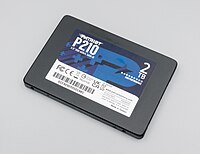
Photo from wikipedia
Knowing how much measurement noise is in a signal is critical for evaluating the overall performance of a satellite observation. We developed a triple collocation observation (TCO) algorithm for estimating… Click to show full abstract
Knowing how much measurement noise is in a signal is critical for evaluating the overall performance of a satellite observation. We developed a triple collocation observation (TCO) algorithm for estimating measurement noise by collocation comparing the local deviations of three satellite data sets. When we evaluated our algorithm with a synthetic data set, the results showed that the algorithm effectively derived measurement noise from satellite signals despite the many intermission signal differences among the satellites. The TCO algorithm produced <6.66% uncertainty in the measurement noise estimates that we derived from the synthetic data set. In addition, to maximally isolate measurement noise from ocean color images, we developed a set of data quality control criteria to apply when identifying synchronous pixel pairs. Using images from the Medium Resolution Spectral Imager II (MERSI II), the Visible Infrared Imaging Radiometer Suite (VIIRS), and the Moderate Resolution Imaging Spectroradiometer (MODIS) instruments, we applied our data quality control criteria and found that the TCO algorithm produced measurement noise consistent with the measured prelaunch or specifications for VIIRS and MERSI II instrument noise. However, the TCO measurement noise was significantly lower than the spaced MODIS noise because MODIS’s extended service time likely produced instrument degradation. Overall, MODIS performed better than MERSI II but worse than VIIRS. Furthermore, we found that the residual error in remote sensing reflectance exponentially decreased as the measurement signal-to-noise ratio (MSNR) increased. Because of this exponential relationship, the MSNR should not be lower than 181 to achieve the <5% uncertainty goal of remote sensing reflectance at 443 nm that NASA proposed. Our results suggest that the TCO algorithm is an effective approach for comprehensively estimating and comparing instrument performance.
Journal Title: IEEE Transactions on Geoscience and Remote Sensing
Year Published: 2022
Link to full text (if available)
Share on Social Media: Sign Up to like & get
recommendations!